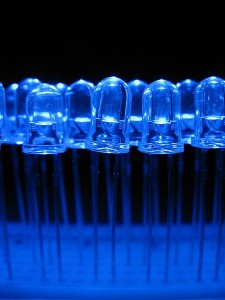Quantum dots are crystals in which the bound states of the electrons are confined in the three spatial dimensions. They have electronic properties between those of semiconductors and discrete molecules. Their characteristics are related to the size of the crystal, so the manufacturing process can precisely control them. My main interest in them lies in the future of computing – the possible development of quantum computers. However, along the way, researchers are trying to put them to use in all sorts of ways.
This time we have a seemingly mundane attempt to put them to use: in lighting. As anyone who can afford a good television/computer/handheld device knows, the cutting edge in lighting is now these guys:
LEDs (light-emitting diodes), which are semiconductor light sources. They are energy-efficient, long-lasting, and easy on the eyes. Actually, the use of energy is key to their long life – the less energy you use, the less heat you generate, and the less wear the light source will experience. Unfortunately, we can’t buy LED lights for room lighting yet (unless I’m behind the times, which is entirely possible), but already quantum dots are popping up as an alternative:
Don’t hold your breath for these little gems, though. According to a phys.org article you can read in full here, the best researchers could do was to combine them with UV LEDs to get a luminous efficiency of 40 lumens/watt. For comparison, the normal incandescent light bulb (which you shouldn’t be using anymore) only gets 15 lumens/watt, but fluorescent tubes manage 100 lumens/watt and LEDs range from 28 to 93. So what’s the benefit?
First, there’s the possibility that they can increase its efficiency. Through acid treatments, they already boosted quantum dot efficiency from under 10% to 40%. There’s also the matter of addressing the color of LED lighting. Since the energy output of quantum dots can be precisely controlled, they can more precisely match color preferences, improving on the harshness of existing lights – particularly fluorescent tubes.
I think, while the researchers are optimistic, quantum dots look like a marginal improvement over existing technology, even at 100% efficiency, and it’s not worth retooling factories for a minor improvement. On the bright side, any research into quantum dots might lead to information that will be useful for other applications, so there’s no waste in giving this a try.

